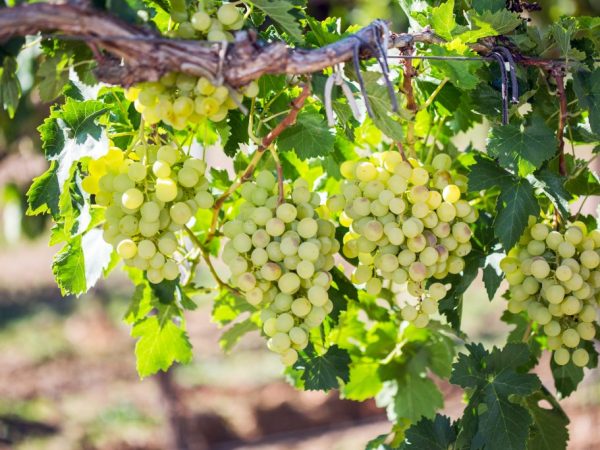Description of grapes Pearls Sabo
The Pearl Sabo grape has several other names. In every country it is different. A distinctive feature of this variety is that it gives high yields, regardless of the region of growth.

Description of grapes Pearls Sabo
Features of the variety
According to the description, the Szabo Pearl variety was developed at the end of the 20th century by Hungarian breeders. There is no information on which varieties resulted from crossing this variety. In 2002, the grapes of this variety were included in the State Register of the Russian Federation. The species is recommended for cultivation in all regions of the country.
Description of the plant:
The average height of the Sabo Pearl bush is 3 m, the stem is dense, powerful. Shoots are not high. This variety belongs to early cultures. Harvest in early July. The flowers are both male and female. The plant does not need pollinators.
- clusters of moderate size, weighing up to 1000 g;
- berries are light green;
- the yield is good: up to 20 kg are harvested from 1 bush.
Purpose and taste
The pulp is characterized by a transparent shade. Seeds are small, in small quantities. This variety contains a large amount of vitamins and minerals necessary for the body. Sugar level 10%. Vitamin C in the amount of 7 g per 100 g of the product. The rind is thin but firm.
Sabo pearls are universal crops. It is consumed not only fresh, but also used for making wine or dessert dishes.
The principle of correct cultivation
Planting should be carried out in sunny areas that are protected from drafts and windy weather, so the variety should be planted near fences or buildings. The best indicators of fruiting are observed on chernozem or loamy soils. It is also important to take into account the acidity of the soil, the level of which should not exceed 3%. Otherwise, it is obligatory to carry out liming of the soil (2 kg / m² of lime). Planting should be carried out in the fall, before the onset of frost. A hole is prepared in advance, measuring 50x70 cm. Next to it, a pin made of metal is dug in, to which a seedling is later tied.
A young seedling (up to 2 years old) is placed inside the hole. He must be vaccinated and not sick. The optimal root length is about 20 cm. The height of the seedling itself should not exceed 50 cm. The roots of the seedling are sprinkled so that the root collar is not buried under the ground. After that, water the hole with water and tie the plant to the prepared support. The distance between the bushes is kept at 4 m.
Care advice

This variety does not tolerate over-watering.
Watering is rarely carried out, since the plant does not tolerate waterlogging of the soil. Water the bushes as the soil dries. Each plant should have 20 liters of warm, settled water. After 2-3 days, weeding the beds is carried out, it is worth uprooting the weeds, on which pests often parasitize.
Pruning is done in spring and fall.In the spring, it is worth removing the antennae and dry areas that appear. This will reduce the level of false ovaries. In the autumn, extra eyes are removed. There should be no more than 8. At this time, the crown is thinned out. After the bunches are ripe, they should be cut off immediately. If you leave them in this position for 5-7 days, then rotting of the fruit will begin. The garter of the bush is carried out as it grows.
Before flowering, the culture is fed with potassium compounds (40 g per 10 l of water). Before fruiting, the plant is watered with a solution of phosphorus fertilizers (50 g per 10 l of water). If necessary, in the fall, mulch the soil with humus and straw to protect the roots from frost.
Pests and diseases
The description of the Pearl Sabo grape variety indicates that the variety has a low immune system, therefore it is often affected by powdery mildew, fruit rot and fusarium.
- There is no effective remedy for powdery mildew. We'll have to eradicate the entire plant.
- A solution of colloidal salt (3 g per 10 liters of water) will help get rid of fruit rot.
- In the fight against fusarium, a manganese solution (5 g per 10 l of water) will come to the rescue.
From the pests, the moth and lobe are isolated. It is worth fighting the moth with a solution of Bordeaux liquid (4 g per 10 liters of water). A tincture of garlic or onion (300 ml of garlic or onion juice per 10 liters of water) will help to destroy the midge. As a prophylaxis against pests and diseases, spraying with copper sulfate (50 g per 10 l of water) is carried out.
Conclusion
If you adhere to all these rules, then the cultivation of a grape crop will not be difficult. As a result, you will grow high-quality tasty products that are easy to prepare a variety of dishes and drinks.


